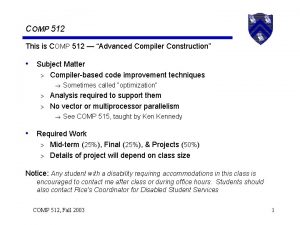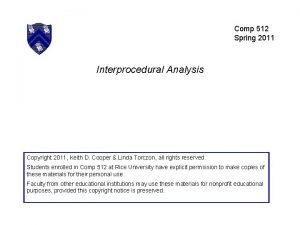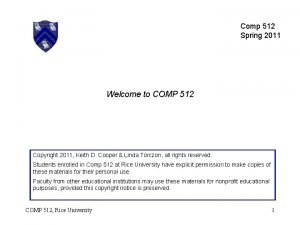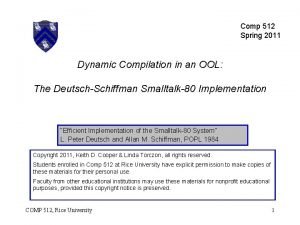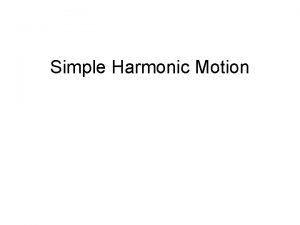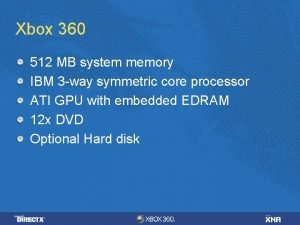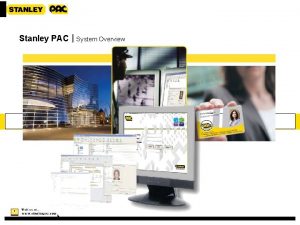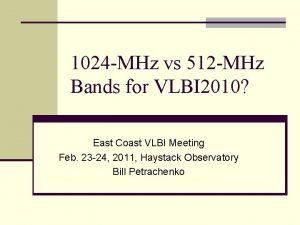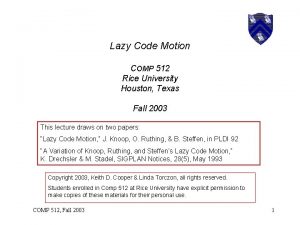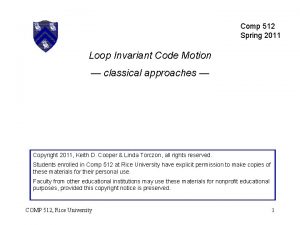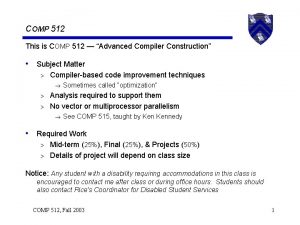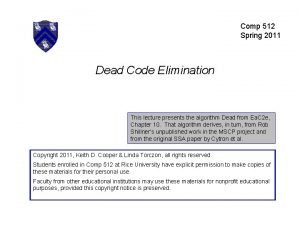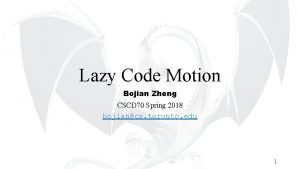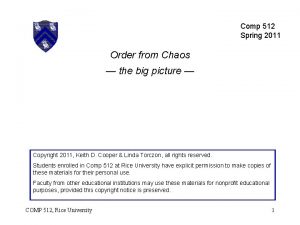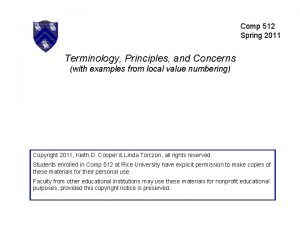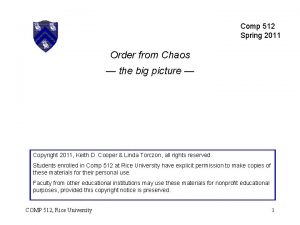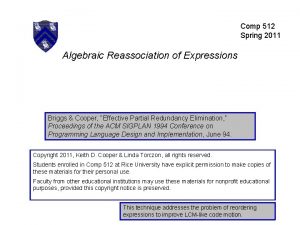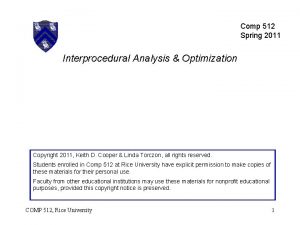Comp 512 Spring 2011 Lazy Code Motion Lazy
















- Slides: 16

Comp 512 Spring 2011 Lazy Code Motion “Lazy Code Motion, ” J. Knoop, O. Ruthing, & B. Steffen, in Proceedings of the ACM SIGPLAN 92 Conference on Programming Language Design and Implementation, June 1992. “A Variation of Knoop, Ruthing, and Steffen’s Lazy Code Motion, ” K. Drechsler & M. Stadel, SIGPLAN Notices, 28(5), May 1993 § 10. 3. 1 of Ea. C 2 e Copyright 2011, Keith D. Cooper & Linda Torczon, all rights reserved. Students enrolled in Comp 512 at Rice University have explicit permission to make copies of these materials for their personal use. Faculty from other educational institutions may use these materials for nonprofit educational purposes, provided this copyright notice is preserved. COMP 512, Rice University Drechsler & Stadel give a much more complete and satisfying example. 1

Redundant Expression An expression is redundant at point p if, on every path to p 1. It is evaluated before reaching p, and 2. Non of its constitutent values is redefined before p Example a b+c Some occurrences of b+c are redundant a b+c COMP 512, Rice University b b+1 a b+c * 2

Partially Redundant Expression An expression is partially redundant at p if it is redundant along some, but not all, paths reaching p Example b b+1 a b+c Inserting a copy of “a b + c” after the definition of b can make it redundant COMP 512, Rice University a b+c fully redundant? * 3

Loop Invariant Expression Another example x y*z a b*c x y*z b+c is partially redundant here a b*c Loop invariant expressions are partially redundant • Partial redundancy elimination performs code motion • Major part of the work is figuring out where to insert operations COMP 512, Rice University 4

Lazy Code Motion The concept • Solve data-flow problems that show opportunities & limits > Availability & anticipability • Compute INSERT & DELETE sets from solutions • Linear pass over the code to rewrite it (using INSERT & DELETE) The history • Partial redundancy elimination (Morel & Renvoise, CACM, 1979) • Improvements by Drechsler & Stadel, Joshi & Dhamdhere, Chow, Knoop, Ruthing & Steffen, Dhamdhere, Sorkin, … • All versions of PRE optimize placement > Guarantee that no path is lengthened • LCM was invented by Knoop et al. in PLDI, 1992 • Drechsler & Stadel simplified the equations COMP 512, Rice University PRE and its descendants are conservative Citations for the critical papers are on the title page. 5

Lazy Code Motion The intuitions LCM operates on expressions • Compute available expressions It moves expression evaluations, not assignments • Compute anticipable expressions • From AVAIL & Ant, we can compute an earliest placement for each expression • Push expressions down the CFG until it changes behavior Assumptions • Uses a lexical notion of identity (not value identity) • ILOC-style code with unlimited name space • Consistent, disciplined use of names > Identical expressions define the same name > No other expression defines that name COMP 512, Rice University } Avoids copies Result serves as proxy 6

Digression in Chapter 5 of EAC: “The impact of naming” Lazy Code Motion The Name Space • ri + rj rk, always, with both i < k and j < k • We can refer to ri + rj by rk • Variables must be set by copies (hash to find k) (bit-vector sets) No consistent definition for a variable > Break the rule for this case, but require rsource < rdestination > To achieve this, assign register names to variables first > Without this name space • LCM must insert copies to preserve redundant values • LCM must compute its own map of expressions to unique ids LCM operates on expressions COMP 512, Rice University It moves expression evaluations, not assignments 7

Lazy Code Motion Local Predicates • DEEXPR(b) contains expressions defined in b that survive to the end of b (downward exposed expressions) e DEEXPR(b) evaluating e at the end of b produces the same value for e • UEEXPR(b) contains expressions defined in b that have upward exposed arguments (both args) (upward exposed expressions) e UEEXPR(b) evaluating e at the start of b produces the same value for e • EXPRKILL(b) contains those expressions that have one or more arguments defined (killed ) in b (killed expressions) e EXPRKILL(b) evaluating e produces the same result at the start and end of b COMP 512, Rice University We have seen all three of these previously. 8

Lazy Code Motion Availability AVAILIN(n) = m preds(n) AVAILOUT(m), n ≠ n 0 AVAILOUT(m) = DEEXPR(m) (AVAILIN(m) EXPRKILL(m)) Initialize AVAILIN(n) to the set of all names, except at n 0 Set AVAILIN(n 0) to Ø Interpreting AVAIL • e AVAILOUT(b) evaluating e at end of b produces the same value for e. AVAILOUT tells the compiler how far forward e can move • This differs from the way we talk about AVAIL in global redundancy elimination; the equations, however, are unchanged. COMP 512, Rice University 9

Lazy Code Motion Anticipability is identical to Very. Busy expressions Anticipability ANTOUT(n) = m succs(n) ANTIN(m), n not an exit block ANTIN(m) = UEEXPR (m) (ANTOUT(m) EXPRKILL(m)) Initialize ANTOUT(n) to the set of all names, except at exit blocks Set ANTOUT(n) to Ø, for each exit block n Interpreting ANTOUT • e ANTIN(b) evaluating e at start of b produces the same value for e. ANTIN tells the compiler how far backward e can move • This view shows that anticipability is, in some sense, the inverse of availablilty (& explains the new interpretation of AVAIL) COMP 512, Rice University 10

Lazy Code Motion The intuitions Available expressions • e AVAILOUT(b ) evaluating e at exit of b gives same result • e AVAILIn(b ) e is available from every predecessor of b an evaluation at entry of b is redundant Anticipable expressions • e ANTIN(b ) evaluating e at entry of b gives same result • e ANTOUT(b ) e is anticipable from every successor of b evaluation at exit of b would a later evaluation redundant, on every path, so exit of b is a profitable place to insert e COMP 512, Rice University 11

Lazy Code Motion Earliest placement on an edge EARLIEST(i, j) = ANTIN(j) AVAILOUT(i) (EXPRKILL(i) ANTOUT(i)) EARLIEST(n 0, j) = ANTIN(j) AVAILOUT(n 0) Can move e to head of j & it is not redundant from i and Either killed in i or would not be busy at exit of i insert e on the edge EARLIEST is a predicate • Computed for edges rather than nodes • e EARLIEST(i, j) if (placement ) It can move to head of j, (ANTIN(j)) > It is not available at the end of i and (EXPRKILL(i)) > either it cannot move to the head of i or another edge leaving i prevents its placement in i (ANTOUT(i)) > COMP 512, Rice University 12

Lazy Code Motion Later (than earliest) placement LATERIN(j) = i pred(j) LATER(i, j), j ≠ n 0 LATER(i, j) = EARLIEST(i, j) (LATERIN(i) UEEXPR(i)) Initialize LATERIN(n 0) to Ø x LATERIN(k) every path that reaches k has x EARLIEST(i, j) for some edge (i, j) leading to x, and the path from the entry of j to k is x-clear & does not evaluate x the compiler can move x through k without losing any benefit x LATER(i, j) <i, j> is its earliest placement, or it can be moved forward from i (LATER(i)) and placement at entry to i does not anticipate a use in i (moving it across the edge exposes that use) COMP 512, Rice University Propagate forward until a block kills it (UEEXPR) 13

Lazy Code Motion Rewriting the code INSERT(i, j) = LATER(i, j) LATERIN(j) Can go on the edge but not in j no later placement DELETE(k) = UEEXPR(k) LATERIN(k), k ≠ n 0 Upward exposed (so we will cover it) & not an evaluation that might be used later INSERT & DELETE are predicates Compiler uses them to guide the rewrite step • x INSERT(i, j) insert x at start of j, end of i, or new block • x DELETE(k) delete first evaluation of x in k COMP 512, Rice University If local redundancy elimination has already been performed, only one copy of x exists. Otherwise, remove all upward exposed copies of x * 14

Lazy Code Motion Edge placement • x INSERT(i, j) x Bi Bi Bh Bi x Bj |succs(i)| = 1 x Bj Bk |preds(j)| = 1 Bj Bk |succs(i) > 1 |preds(j)| > 1 Three cases A “Critical” Edge • |succs(i)| = 1 insert at end of i • | succs(i)| > 1, but |preds(j)| = 1 insert at start of j • | succs(i)| > 1, & |preds(j)| > 1 create new block in <i, j> for x COMP 512, Rice University 15

Lazy Code Motion Example B 1: r 1 1 r 2 r 0 + @ m if r 1< r 2 B 2, B 3 B 2: … r 20 r 17 * r 18. . . r 4 r 1 + 1 r 1 r 4 if r 1 < r 2 B 2, B 3: . . . Critical edge rule will create landing pad when needed, as on edge (B 1, B 2) COMP 512, Rice University B 1 B 2 B 3 Example is too small to show off Later Insert(1, 2) = { r 20 } Delete(2) = { r 20 } 16
